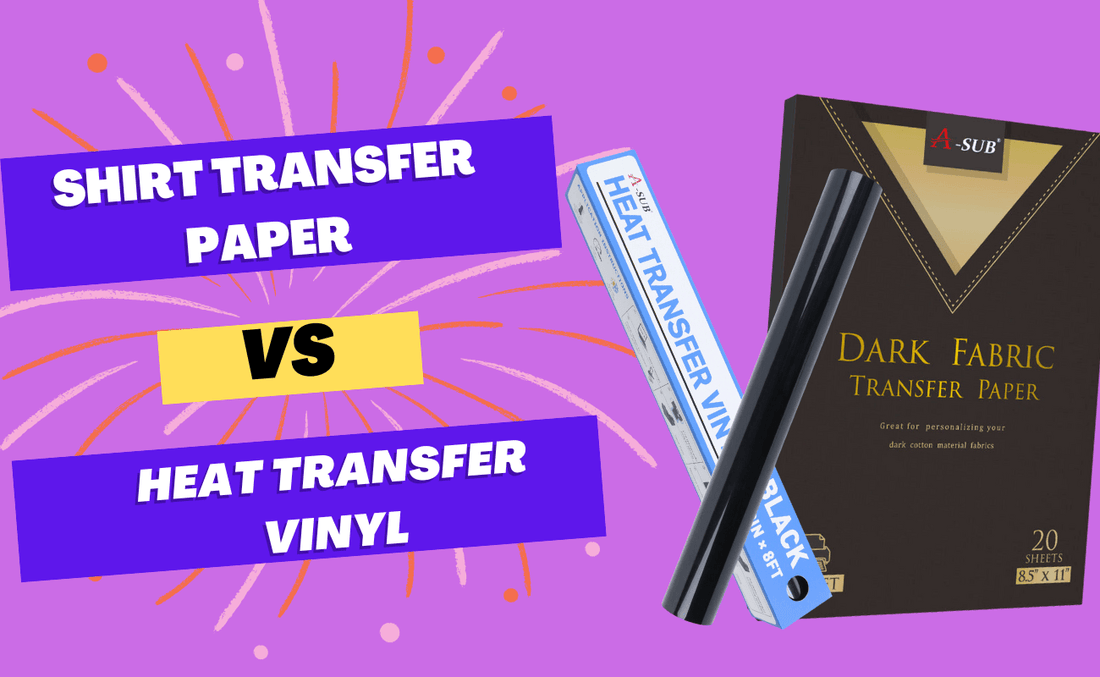Shirt transfer paper vs Heat Transfer Vinyl ?! Pros and Cons !

shirt transfer paper and heat transfer vinyl are two popular methods of transferring designs onto fabric. Both approaches have pros and cons, and it's important to understand the differences between the two before deciding which one to use for your project.
Introduction
1.T-shirt transfer paper(Two step heat transfer method)
T-shirt transfer paper works by imprinting a design on a special type of paper, which is then transferred to the fabric using heat. Transfer paper is often used with a special type of printer called a white toner transfer printer, which uses white toner instead of black toner to print a design onto the transfer paper. After you print your design onto transfer paper, place it on the fabric and heat it with a heat press or iron to activate the adhesive on the paper and transfer the design to the fabric.

2.Heat transfer vinyl
Heat transfer vinyl, on the other hand, works by cutting designs from a special type of vinyl and applying them to fabric with heat. Vinyl is usually cut using a specialized machine called a vinyl cutter, which uses a small blade to cut designs from vinyl sheets. Once the design is cut, it is placed on the fabric and then heated using a heat press or iron, activating the adhesive on the vinyl and transferring the design to the fabric.

Comparison of T-shirt transfer paper and Heat transfer vinyl.
1.Cost
When it comes to cost, there are several factors to consider. T-shirt transfers require a white toner transfer printer, which can be very expensive. Prices for these printers range from $4,000 to $7,000, but there are some financing options as well. Also, the transfer paper itself costs about $0.25 each. On the other hand, heat transfer vinyl requires a vinyl cutter, which can be more affordable. Prices for these cutters range from $200 to $7,000, depending on the size and complexity of the machine. Vinyl itself is also relatively inexpensive, costing about $12 for a roll of vinyl.
Therefore, heat transfer vinyl is often the more cost-effective option in terms of upfront cost.
2.Complexity of operation
In terms of complexity of operation, both methods require a certain level of skill and practice to achieve the best results. T-shirt transfers require precise alignment of the transfer to the fabric, and it's important to use the correct temperature and pressure settings on your heat press or iron. Heat transfer vinyl, on the other hand, requires precise cutting of the vinyl and careful weeding, which means removing excess vinyl, before applying the design to the fabric.
Therefore, in comparison, the operation process of heat transfer vinyl is a little more complicated.
3.Design Variety
Design Variety is another area where the two approaches differ. T-shirt transfers are often used for designs that require full-color printing or intricate images because it allows high-resolution printing on transfer paper. On the other hand, heat transfer vinyl is often used for simpler designs or text-based designs because it's easier to cut letters and shapes out of the vinyl, and you can only use one color per vinyl layer.
However, there are also many different types of heat transfer vinyl available, including glitter, metallic, and holographic vinyl, which can add some variety to your designs.
4.Durability
In the end.durability is an important factor to consider when choosing between the two methods. Both t-shirt transfers and thermal vinyl can withstand repeated washing and abrasion about 30 to 40 times, but it is recommended to wash them inside and out.
Conclusion
In conclusion, both t-shirt transfers and sublimation vinyl have pros and cons, and the choice between the two depends on your specific needs and preferences. T-shirt transfers are often used for full-color or intricate designs, but are more expensive upfront. On the other hand, heat transfer vinyl is more cost-effective upfront and is available in a variety of vinyl types and colors. However, it may not be suitable for more complex designs.
In the end, it's important to weigh cost, handling complexity, design variety, and durability when choosing between t-shirt transfers and heat transfer vinyl. Both methods require a certain level of skill and practice to achieve the desired results, but with the right equipment and technique, both can produce high-quality results.
No comments




0 comments